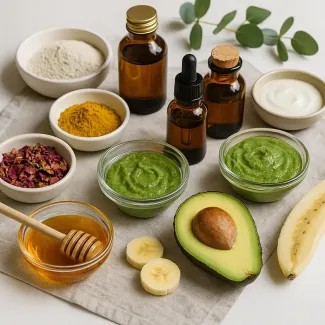
Restore Your Skin’s Radiance Naturally with Nourishing Oils and Homemade Masks
Gentle routines and powerful botanicals to support glowing, healthy skin without synthetic additives
Understanding your skin’s natural balance
Our skin is a living ecosystem, constantly renewing itself, responding to our environment, and reflecting our internal health. When cared for with the right ingredients, especially plant-based oils and homemade masks, it can radiate health, vitality, and natural glow. Unlike synthetic cosmetics that often strip or stress the skin barrier, natural skincare works with the skin’s biology, not against it.
Your skin naturally produces sebum, a protective oil that shields against dehydration and environmental damage. By aligning your care routine with your skin’s natural oils — rather than overriding them — you support your skin’s resilience, texture, and youthful elasticity.
Why less is more in natural skin care
Minimalism in skin care is not just a trend; it's a return to ancestral practices that relied on oils, clays, herbs, and other plant-based ingredients. The less we interfere with the skin's microbiome and barrier function, the more it thrives. Applying a few well-chosen, high-quality oils or masks can provide:
- Antioxidants to fight oxidative stress
- Essential fatty acids to nourish the lipid layer
- Phytonutrients that calm inflammation
- Hydrating molecules like natural glycerin and aloe vera
Instead of layering multiple chemical-laden products, choosing a few targeted natural ingredients brings both simplicity and effectiveness.
Choosing the right natural oils for your skin type
Dry or dehydrated skin
For those with dry skin, oils rich in oleic acid help lock in moisture and restore softness. Some excellent choices include:
- Avocado oil: deeply nourishing, rich in vitamins A, D, and E
- Sweet almond oil: lightweight yet hydrating
- Marula oil: high in antioxidants, ideal for mature or weather-exposed skin
Apply oils after dampening the skin to seal in water and improve absorption.
Oily or acne-prone skin
Contrary to popular belief, oil can balance oily skin if the right ones are used. Oils with high linoleic acid content are ideal:
- Grapeseed oil: light, non-comedogenic, and a natural astringent
- Jojoba oil: mimics sebum and helps regulate overproduction
- Hemp seed oil: high in omega-3 and omega-6, soothes irritation
These oils help regulate sebum and maintain a clear complexion.
Sensitive or reactive skin
If your skin is prone to redness, rashes, or irritation, opt for calming oils with anti-inflammatory properties:
- Chamomile oil: gentle and soothing
- Calendula oil: supports healing and barrier repair
- Argan oil: contains tocopherols and phenols that reduce sensitivity
Always patch-test new oils before applying them across the face.
Homemade face masks to revitalize your skin
Clay-based detox mask
A classic way to draw out impurities and balance oil production is through natural clays. Mix:
- 1 tbsp bentonite clay
- 1 tbsp rose water or green tea
- A few drops of tea tree oil (optional, for acne-prone skin)
Apply for 10–15 minutes, avoiding the eye area, and rinse thoroughly.
Honey and turmeric glow mask
Honey is a natural humectant, drawing moisture into the skin. Turmeric brings anti-inflammatory and brightening properties. Mix:
- 1 tbsp raw honey
- 1/2 tsp organic turmeric
- 1 tsp yogurt or aloe vera gel
This mask can brighten dull skin and even out skin tone over time.
Avocado and banana hydration mask
Perfect for dry or flaky skin, this creamy blend nourishes deeply:
- 1/4 ripe avocado
- 1/4 ripe banana
- 1 tsp olive oil or jojoba oil
Mash ingredients into a smooth paste and leave on for 15 minutes.
Natural exfoliation methods for smooth skin
Oatmeal and yogurt scrub
Ground oats are gentle enough for sensitive skin and provide natural saponins that cleanse without irritation.
- 1 tbsp finely ground oats
- 1 tbsp plain yogurt
- Optional: a few drops of lavender oil
Massage in circular motions and rinse with lukewarm water.
Rice flour and honey polish
Rice flour is a traditional Asian exfoliant that gently buffs away dead cells.
- 1 tbsp rice flour
- 1 tbsp honey
- A dash of rose water
Use 1–2 times per week for bright and even-toned skin.
Daily natural skincare routine
Morning ritual
- Rinse with lukewarm water (skip harsh cleansers)
- Apply a hydrating mist with aloe, rose water, or cucumber
- Use a few drops of facial oil, massaged into damp skin
- Finish with a natural sunscreen containing zinc oxide or red raspberry seed oil
Evening ritual
- Remove makeup with jojoba or almond oil on a cotton pad
- Cleanse with honey or oatmeal cleanser
- Use a soothing mask or serum once or twice weekly
- Seal in moisture with argan, marula, or avocado oil
Regular massage during oil application helps boost circulation and lymphatic drainage, enhancing your glow.
How to transition to natural skincare
The adjustment phase
When switching to natural skin care, your skin may go through an adjustment period. This might include slight breakouts or dryness as your skin balances itself. This is temporary — consistency is key. Avoid switching between products too quickly.
Choosing quality ingredients
Always look for cold-pressed, unrefined, organic oils whenever possible. Store them in a cool, dark place to preserve freshness. Avoid oils with added fragrance or alcohol, which can irritate the skin.
Herbs and botanicals for radiant skin
Rose petals and hibiscus
These flowers contain natural AHAs (alpha hydroxy acids) that gently exfoliate. A simple infusion can act as a brightening toner.
Green tea and chamomile
Rich in polyphenols, these herbs reduce inflammation and free radical damage. Use them as a base for masks or as hydrating sprays.
Aloe vera and cucumber
These classics soothe and hydrate all skin types. Mix aloe with oils to create lightweight moisturizers or use cucumber juice as a refreshing toner.
Tips for long-lasting glow
- Drink plenty of water and eat skin-nourishing foods rich in omega-3, zinc, and vitamin C
- Avoid over-exfoliating — 1–2 times per week is enough
- Sleep on a clean, soft pillowcase (ideally silk or bamboo)
- Protect your skin from pollution and UV rays
- Stay consistent — natural skin care is about long-term support, not overnight miracles
Common mistakes in DIY skin care
- Using essential oils without dilution
- Applying citrus oils during the day (can increase sun sensitivity)
- Overusing exfoliants or harsh clays
- Mixing too many active ingredients at once
- Ignoring patch tests
Start with a simple approach, observe how your skin responds, and build your routine slowly.
Seasonal adaptations for natural skincare
Winter
Use richer oils like avocado or argan, and hydrating masks 2–3 times weekly. Protect skin from heaters and cold winds with occlusive balms made from shea butter or cocoa butter.
Summer
Opt for lighter oils like grapeseed or rosehip, and introduce more cooling herbs like mint, cucumber, and aloe. Refresh with herbal mists during the day.
How age affects your natural skin care needs
In your 30s
Start focusing on hydration and early antioxidant support. Rosehip, squalane, and raspberry seed oil are ideal.
In your 40s
Support collagen and elasticity with marula oil, pomegranate oil, and sea buckthorn. Regular massage and gentle AHAs help renew texture.
50 and beyond
Emphasize deep nourishment, barrier repair, and hydration. Use richer masks with ingredients like honey, yogurt, oats, and avocado. Oils like borage and evening primrose become essential.
Supporting skin health from the inside
- Consume healthy fats (avocados, flaxseeds, walnuts)
- Include antioxidant-rich berries in your diet
- Avoid refined sugar and dairy if sensitive
- Drink herbal teas like nettle, dandelion, and rooibos
- Practice stress reduction: meditation, breathwork, nature walks
Tools to boost natural skincare
- Gua Sha or jade rollers for facial massage
- Dry brushing to stimulate lymphatic flow
- Face steamers with herbs like chamomile or lavender
- Silk pillowcases and filtered showerheads to reduce skin irritation
Summary of daily oil usage
- Use jojoba or grapeseed in the morning for lightweight moisture
- Switch to argan or avocado at night for deep repair
- Combine oils with aloe vera gel for hydration without greasiness
- Use neem oil as a spot treatment for blemishes
- Apply rosehip oil to fade scars and uneven skin tone
Understanding your skin’s rhythm
Your skin follows circadian rhythms, which means it’s more prone to repair and absorption at night. Using rich oils and reparative masks in the evening aligns your routine with these rhythms. During the day, your skin needs protection and antioxidants.
Supporting your skin with natural, botanical-based care not only enhances appearance, but also contributes to overall skin resilience, emotional well-being, and a deeper connection with your body’s wisdom.





